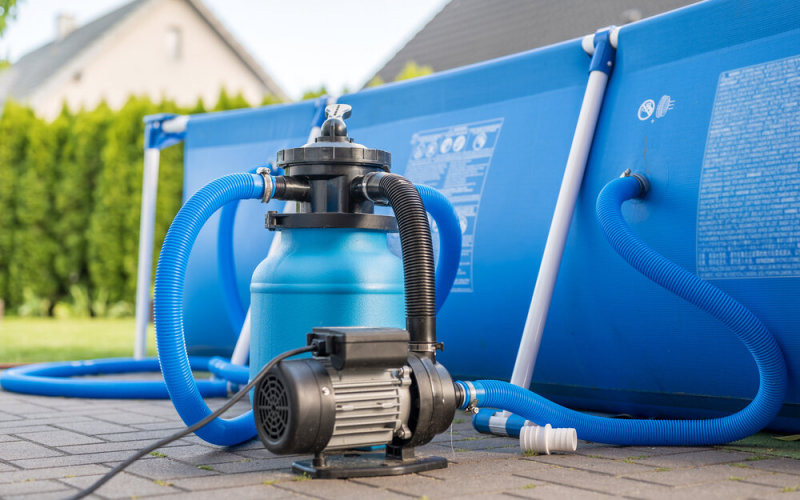Amidst the joy and relaxation that swimming pools offer, lies a sobering reality: the alarming number of drowning incidents worldwide.
Shockingly, children account for 50% of the 1.2 million lives lost annually. In the United States alone, one in every five drowning-related deaths involves children under 14, with a third occurring near their homes.
However, by implementing appropriate safety measures, these tragedies can be prevented. This article will explore the essential guidelines for pool safety, including:
- Supervision
- Rules
- Swimming lessons
- CPR
- Equipment safety
- And more.
Key Takeaways
- Proper supervision is crucial to prevent drowning incidents, especially for children.
- It is important to establish clear rules before using the pool and avoid alcohol consumption while supervising.
- Teaching children how to swim and investing in professional swimming lessons can significantly reduce the risk of drowning.
- Pool drains should be covered, fences and alarms should be installed, and safety measures such as pool covers, float lines, and life preservers should be utilized to ensure pool safety.
Importance of Pool Safety
Given the knowledge provided, it is crucial to prioritize pool safety measures. The importance of pool safety cannot be overstated, especially when considering the significant risks involved. Drowning is a leading cause of death worldwide, with 1.2 million people losing their lives annually. Shockingly, 50% of drowning victims are children, and in the United States, 1 in 5 drowning deaths are children under the age of 14. Furthermore, a third of child drowning incidents occur in or around the home. These statistics highlight the urgent need for effective pool safety practices to prevent such tragic accidents.
Understanding the importance of pool safety begins with recognizing that drowning incidents are preventable. By implementing proper safety precautions, the risks can be significantly reduced. This includes ensuring constant supervision of children in the water, never leaving them unattended, and making sure responsible adults are present to watch over them. Avoiding alcohol consumption while supervising is also crucial as it impairs judgment and reaction time. Additionally, establishing clear rules before enjoying the pool helps to instill a culture of safety and responsibility.
With the understanding of the importance of pool safety established, it is essential to transition into the subsequent section about supervision and rules. By following these guidelines, we can create a safer pool environment for everyone involved.
Supervision and Rules
- Prioritize the safety of pool users by implementing effective supervision and clear rules. Supervision and rules are crucial in maintaining a safe pool environment for everyone. By ensuring that there is constant adult supervision and establishing clear guidelines, the risk of accidents and injuries can be significantly reduced.
To facilitate a better understanding, here is a table outlining important pool rules:
| Supervision and Rules |
|---|
| Supervise children in the water at all times |
| Never leave a child unattended in the water |
| Make sure responsible adults are watching the children |
| Avoid alcohol consumption while supervising |
| Establish clear rules before enjoying the pool |
Supervising children in the water at all times is vital, as it only takes a few seconds for an accident to happen. It is important to never leave a child unattended in the water, even if they are using floatation devices. Responsible adults should be designated to watch over the children, ensuring their safety. It is crucial for the adults to avoid alcohol consumption while supervising, as it impairs judgment and reaction time.
In addition to supervision, clear rules should be established before anyone enters the pool. These rules can include guidelines such as no running or diving, no pushing or rough play, and no swimming alone. By setting these rules, everyone using the pool can understand and follow the safety guidelines, reducing the risk of accidents.
Swimming Lessons and CPR
To ensure a comprehensive approach to pool safety, it is imperative to prioritize swimming lessons and CPR training. Teaching children how to swim is a crucial step in preventing drowning incidents. Investing in professional swimming lessons, if possible, can provide children with the necessary skills and confidence in the water. Local YMCAs, state parks, and community pools often offer swimming programs for both children and adults. Taking advantage of these resources can significantly reduce the risk of drowning.
In addition to swimming lessons, learning CPR is another essential skill that can save lives. CPR, or cardiopulmonary resuscitation, is a technique used to revive someone who has stopped breathing or whose heart has stopped beating. Taking a CPR training course can provide individuals with the knowledge and skills needed to respond effectively in emergency situations. Local organizations and community centers often offer CPR courses, and some employers may even provide free or low-cost training.
By combining swimming lessons and CPR training, individuals can be better prepared to handle pool-related emergencies. Swimming lessons equip individuals with the ability to navigate the water safely, reducing the likelihood of accidents. CPR training, on the other hand, empowers individuals to respond promptly and effectively in the event of a drowning incident or other water-related emergencies.
Pool Drains and Equipment Safety
When it comes to pool safety, it is essential to address the potential dangers posed by pool drains and equipment.
Educating children about the dangers of pool drains and teaching them to stay away from them is crucial.
Additionally, ensuring that all pool drains have proper covers is necessary to prevent accidents and injuries.
Installing fences around the pool area adds an extra layer of protection and helps to keep children away from potential hazards.
Drain Dangers and Education
Pool drain dangers and education are crucial aspects of ensuring pool safety.
It is important to teach children to stay away from pool drains and explain the potential danger they pose. All drains should be equipped with proper covers to prevent accidents.
Pool drains can be dangerous due to their suction power, which can trap swimmers and cause injury or drowning.
To further enhance safety, it is recommended to install fences around the pool area, use alarms to alert of any pool activity, cover the pool when not in use, and use float lines to designate safe swimming areas.
Additionally, having life preservers readily available can be essential in case of emergencies.
Proper Drain Coverings
Proper drain coverings are essential for maintaining pool safety and preventing accidents related to pool drains and equipment. When it comes to pool drains, safety should be the top priority. Here are five reasons why proper drain coverings are crucial:
- Prevents entrapment: Proper drain coverings help prevent entrapment incidents by reducing the risk of suction-related accidents.
- Ensures water circulation: Good drain coverings promote proper water circulation, ensuring a safe and clean swimming environment.
- Protects against injuries: Well-fitted covers prevent injuries caused by sharp edges or protruding drain equipment.
- Reduces maintenance costs: By preventing debris from entering the pool's plumbing system, proper drain coverings help reduce maintenance and repair expenses.
- Complies with regulations: Installing compliant drain covers ensures that your pool meets the required safety standards and regulations.
With proper drain coverings in place, you can now move on to the next crucial aspect of pool safety: the importance of pool fences.
Importance of Pool Fences
The installation of pool fences plays a vital role in ensuring the safety and security of individuals, particularly in relation to pool drains and equipment. Pool fences act as a physical barrier, preventing unauthorized access to the pool area, and reducing the risk of accidents. They provide a layer of protection for children and pets, who may be attracted to the water and unaware of the dangers associated with pool drains and equipment. To emphasize the importance of pool fences, consider the following table:
| Benefits of Pool Fences |
|---|
| Prevents unauthorized access to the pool area |
| Reduces the risk of accidents and drowning incidents |
| Provides a barrier between children and pool drains and equipment |
Pool Fences
When it comes to pool safety, installing a pool fence is essential. The height of the fence should meet the recommended requirement of at least four feet to prevent children from easily climbing over.
There are various types of pool fences available, and it is important to choose one that children cannot open without an adult.
Additionally, gate and door alarms can be installed for added protection, alerting adults whenever someone enters the pool area.
Fence Height Requirements
A recommended minimum height for pool fences is four feet, according to industry standards. This height requirement ensures that the fence provides an effective barrier, preventing children from easily climbing over and accessing the pool area unsupervised.
Here are some reasons why fence height requirements are essential:
- Safety: A higher fence makes it more difficult for children to access the pool, reducing the risk of accidents and drowning.
- Deterrence: A taller fence acts as a visual deterrent, discouraging children from attempting to enter the pool area without supervision.
- Compliance: Meeting the recommended fence height requirements ensures adherence to local safety regulations and standards.
- Peace of mind: Having a properly installed and adequately high pool fence provides peace of mind for parents and caregivers, knowing that children are protected and safe.
- Liability: By meeting fence height requirements, homeowners can minimize potential liability in case of accidents or injuries.
It is crucial to prioritize fence height requirements when implementing pool safety measures to create a secure environment for everyone.
Types of Pool Fences
There are several types of pool fences available for ensuring safety and preventing unauthorized access to the pool area, in accordance with pool safety guidelines.
One common type is the traditional wrought iron fence, which provides a sturdy barrier while allowing visibility into the pool area.
Another option is the glass fence, which offers an unobstructed view and adds a modern aesthetic to the pool area.
For those seeking a more affordable option, mesh fences are a popular choice. These fences are made of durable materials and are easy to install and remove.
Additionally, there are also removable pool fences that can be easily taken down when not in use. Each type of pool fence serves the purpose of keeping the pool area secure and safe.
Moving on to the next topic, gate and door alarms provide an additional layer of protection.
Gate and Door Alarms
Moving on to the topic of gate and door alarms, these additional safety measures provide an extra layer of protection for pool fences. Gate and door alarms are essential in ensuring the safety of children and preventing accidental drownings.
Here are five reasons why gate and door alarms are crucial for pool safety:
- Enhanced Security: Gate and door alarms alert adults when someone enters or exits the pool area, helping to prevent unauthorized access and potential accidents.
- Immediate Awareness: The alarms provide instant notification, allowing adults to respond quickly and take necessary action in case a child or an inexperienced swimmer enters the pool area unsupervised.
- Extra Deterrence: The presence of gate and door alarms acts as a visual deterrent, discouraging children from attempting to access the pool area without proper supervision.
- Peace of Mind: Gate and door alarms provide parents and caregivers with peace of mind, knowing that an additional safety measure is in place to protect their loved ones.
- Compliance with Regulations: Many local authorities require the installation of gate and door alarms as part of pool safety regulations, ensuring that your pool is up to code.
Alarms, Covers, Float Lines, and Life Preservers
One essential aspect of pool safety is the use of alarms, covers, float lines, and life preservers. These safety measures play a crucial role in preventing accidents and ensuring the well-being of pool users, particularly children. Let's take a closer look at each of these safety features:
| Safety Measure | Description | Importance |
|---|---|---|
| Alarms | Pool alarms are designed to alert you of any pool activity, such as when someone enters the water. They can be installed on the pool itself, gates, or doors leading to the pool area. | Alarms provide an extra layer of protection by notifying adults of potential dangers and allowing them to respond quickly. |
| Covers | Pool covers are an effective way to secure the pool when it is not in use. Safety covers, which meet specific weight-holding standards, are especially important as they prevent accidental falls into the water. It is important to note that not all pool covers are safety covers. | Pool covers act as a physical barrier, preventing unauthorized access and reducing the risk of drowning incidents. |
| Float Lines | Float lines are used to designate safe swimming areas within the pool. They provide a visual barrier between the shallow and deep ends, helping swimmers stay within their abilities and avoid potential hazards. | Float lines promote safe and organized swimming by clearly delineating different areas of the pool. |
| Life Preservers | Life preservers, available in jacket and throwable flotation devices, are essential for emergencies. They provide buoyancy and support to individuals in distress, giving them a better chance of staying afloat until help arrives. Pool safety hooks can also provide more control than throwable life preservers. | Life preservers are crucial in rescue situations, ensuring the safety of individuals who may be unable to swim or in need of immediate assistance. |
Conclusion
To conclude, implementing these essential pool safety measures significantly reduces the risk of accidents and ensures a secure swimming environment for all individuals involved. By following these guidelines, you can protect yourself, your loved ones, and anyone who uses the pool. Remember, pool safety is not something to take lightly – it is a matter of life and death.
Consider the following:
- Supervision and Rules: Always supervise children in the water and establish clear rules before enjoying the pool. Never leave a child unattended and avoid alcohol consumption while supervising.
- Swimming Lessons and CPR: Teach children how to swim and consider investing in professional swimming lessons. Additionally, learn CPR and take a training course. These skills can be invaluable in an emergency situation.
- Pool Drains and Equipment Safety: Teach children to stay away from pool drains and ensure that all drains have proper covers. Install fences around the pool area, use alarms to alert you of any pool activity, and cover the pool when not in use. Designate safe swimming areas with float lines and have life preservers available for emergencies.
- Pool Fences, Alarms, Covers, Float Lines, and Life Preservers: Check local requirements for yard fencing and install a pool fence that children cannot open without an adult. Consider installing pool alarms, gate alarms, and door alarms for added protection. Use safety covers that meet weight-holding standards and designate safe swimming areas with float lines. Keep life preservers and pool safety hooks on hand for emergencies.
Frequently Asked Questions
Are There Any Specific Guidelines or Regulations for Pool Safety in Residential Areas?
There are specific guidelines and regulations for pool safety in residential areas. These regulations may vary depending on the local requirements. It is important to check with the local authorities to determine the specific guidelines for yard fencing and pool safety measures.
Some common recommendations include:
- Installing a pool fence of at least four feet in height
- Using pool alarms and gate alarms for added protection
- Ensuring that pool covers meet safety standards
- Additionally, float lines and life preservers should be available for emergencies.
What Are Some Common Misconceptions About Pool Safety?
Common misconceptions about pool safety include:
- The belief that floaties or water wings are sufficient for a child's safety, when in fact they are not a substitute for adult supervision.
- Another misconception is that pool covers are always safety covers, when in reality, not all covers meet the necessary weight-holding standards.
- Additionally, some people may underestimate the importance of learning CPR or assume that simply having a pool fence is enough to prevent accidents.
It is crucial to be aware of these misconceptions and take proper safety precautions to ensure pool safety.
How Often Should Pool Equipment, Such as Drains and Covers, Be Inspected and Maintained?
Pool equipment, such as drains and covers, should be inspected and maintained regularly to ensure the safety of pool users. The frequency of inspections and maintenance will depend on various factors, including the type of equipment, usage, and local regulations.
It is recommended to follow manufacturer guidelines for maintenance schedules and conduct regular check-ups to identify any potential issues. Regular inspections and maintenance will help prevent accidents and ensure that the pool equipment is functioning properly.
Are There Any Specific Safety Measures to Consider for Above-Ground Pools?
When it comes to above-ground pools, there are specific safety measures that should be considered.
It is important to ensure that the pool is securely fenced off to prevent unauthorized access.
Installing a sturdy pool ladder with locking mechanisms can also help prevent accidents.
Regularly inspecting and maintaining the pool's equipment, such as drains and covers, is crucial to ensure their proper functioning.
Additionally, having safety equipment such as life preservers readily available is essential in case of emergencies.
What Are Some Additional Resources or Organizations That Provide Support and Education on Pool Safety?
There are several additional resources and organizations that provide support and education on pool safety.
Local chapters of organizations such as the American Red Cross and the National Drowning Prevention Alliance offer educational materials, training courses, and resources for pool safety.
The U.S. Consumer Product Safety Commission (CPSC) also provides information and guidelines on pool safety.
Additionally, community centers, YMCAs, and state parks often offer swim classes and safety programs.
It is recommended to check with local authorities and community organizations for specific resources in your area.




